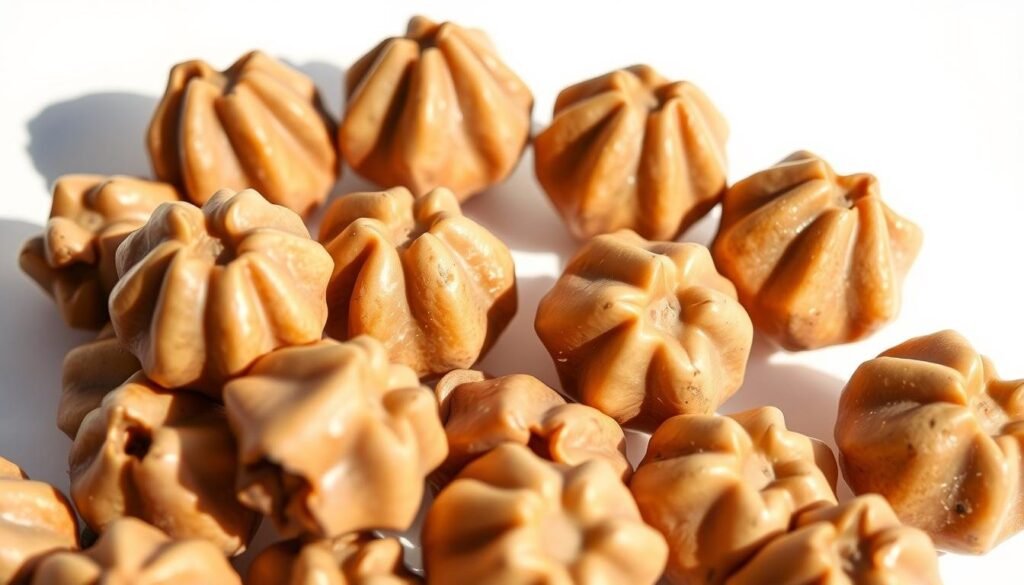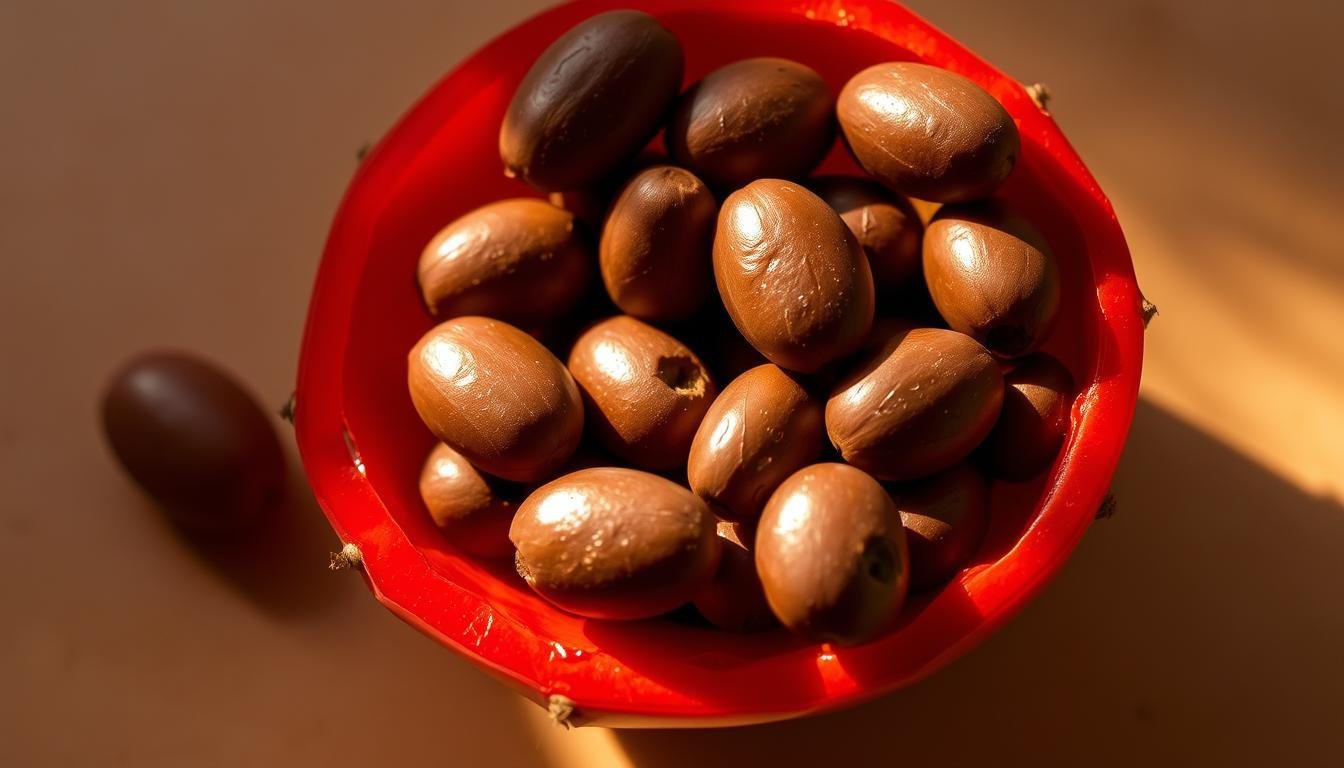Are Prickly Pear Seeds Edible? The prickly pear cactus is known for its vibrant fruits and potential health benefits. As interest in natural and nutritious foods grows, people wonder: are prickly pear seeds edible?
Prickly pear fruits are a delicacy in many cultures and a source of nutrition. The seeds inside these fruits are now being studied for their benefits. Eating these seeds might add nutritional value, but it’s key to know if they’re safe and how to eat them.
We’ll look into the nutritional benefits and safety of prickly pear seeds. This guide aims to give you a full understanding of prickly pear seeds and their uses.
Contents
- 1 Understanding the Prickly Pear Cactus and Its Fruit
- 2 Can You Eat the Seeds of a Prickly Pear?
- 3 Nutritional Benefits of Prickly Pear Seeds
- 4 How to Prepare and Consume Prickly Pear Seeds
- 5 Conclusion: Are Prickly Pear Seeds Edible?
- 6 FAQ
- 6.1 Are prickly pear seeds safe to eat?
- 6.2 How do I avoid glochids and spines when handling prickly pear fruit?
- 6.3 Can I eat prickly pear seeds raw?
- 6.4 What are the nutritional benefits of consuming prickly pear seeds?
- 6.5 How can I incorporate prickly pear seeds into my diet?
- 6.6 Are there any potential allergic reactions or interactions associated with consuming prickly pear seeds?
- 6.7 Can I roast or toast prickly pear seeds to enhance their flavor?
Understanding the Prickly Pear Cactus and Its Fruit
Did you know the prickly pear cactus has fruit that’s tasty and healthy? This cactus is found in the Americas. Its fruit has been a key food for many cultures for a long time.
The fruit of the prickly pear cactus comes in bright colors like reds, yellows, and greens. The flesh is soft and has tiny seeds in a juicy pulp. But, the fruit’s skin is thick and has small spines that can hurt your skin, so be careful.
The seeds inside are small and hard. Some people don’t like them because of their texture. But, they are actually good to eat and full of nutrients. Knowing about the fruit’s structure, including its seeds and skin, helps us see its value in food and health.
Varieties of Prickly Pear
There are many varieties of prickly pear cacti. Each one has fruit that is different in size, color, and taste. The most common types are Opuntia ficus-indica and Opuntia megacantha.
These different types of prickly pear fruit mean there’s something for everyone. You can enjoy it raw, cooked, or in recipes. Knowing about the various types can make your experience even better.
Can You Eat the Seeds of a Prickly Pear?
Prickly pear seeds are found inside the fruit of the prickly pear cactus. They are small and many, stuck in the fruit’s pulp. It’s interesting to know if these seeds are safe to eat.

The seeds have a hard outer shell that is hard to digest. This shell protects the seed, helping it survive in animals’ digestive systems. It also makes it hard for humans to digest.
Studies show that the seed’s hard shell is made of materials that can’t be broken down by digestion. This means the seeds stay the same as they go through the digestive system and are then thrown out.
Passing Through Digestive System
When eaten, prickly pear seeds go through the digestive system without changing much. The digestive enzymes and acids can’t break down the hard shell. So, the seeds don’t get digested in the intestines.
Even though they can’t be digested, eating prickly pear seeds is generally safe. The body can handle these seeds without problems. But, eating a lot of them might make some people feel uncomfortable in their stomach.
In summary, prickly pear seeds are edible but hard to digest because of their tough shell. They pass through the digestive system without being broken down. This means they don’t offer much nutritional value but are not harmful to eat.
Nutritional Benefits of Prickly Pear Seeds
Prickly pear seeds are packed with nutrients. They have protein, fiber, and important vitamins and minerals. Adding them to your meals can boost your nutrition.
Protein and Fiber Content
These seeds are full of dietary fiber and protein. The fiber aids in digestion, and the protein helps muscles and keeps you full.
Vitamins and Minerals
They are also rich in vitamins C, K, and potassium. These nutrients are key for a strong immune system, healthy bones, and heart health.
Prickly pear seeds have antioxidants. These protect the body from damage and may lower disease risk.
Digestive Health Advantages
The seeds’ high fiber supports a healthy gut. They help prevent constipation and keep the gut balanced.
Potential Blood Sugar Regulation
Research shows they might help control blood sugar. This is good news for people with diabetes.
| Nutrient | Amount per 100g | Health Benefit |
|---|---|---|
| Protein | 10g | Supports muscle health |
| Fiber | 20g | Promotes digestive health |
| Vitamin C | 50mg | Boosts immune function |
In summary, prickly pear seeds are a nutritional goldmine. They’re rich in protein, fiber, vitamins, and minerals. Plus, they have antioxidants that support overall health.
How to Prepare and Consume Prickly Pear Seeds
To enjoy prickly pear seeds, you need to know how to prepare them safely. These seeds are edible and can be eaten in different ways. But, it’s important to handle them carefully to avoid irritation from glochids and spines.
Avoiding Glochids and Spines
First, avoid the glochids and spines on the fruit. Glochids are small, hair-like structures that can irritate your skin. To safely handle the fruit, wear gloves and use tongs or tweezers to remove the spines.
Selecting Ripe Fruit
Choosing ripe prickly pear fruit is key for safe eating. A ripe fruit is deep red or purple and soft to the touch. Don’t pick unripe or green fruit, as they’re not ready yet.
Use gloves, tongs, and brushes to handle the fruit. Gently brush off the glochids, then rinse the fruit under running water. This removes any remaining spines or debris.
Eating Whole with the Fruit
Eating prickly pear seeds whole with the fruit is simple. After removing spines and glochids, scoop out the flesh and seeds together. The seeds are full of fiber and can be safely digested.
Grinding for Flour or Meal
You can also grind prickly pear seeds into flour or meal for baking. Dry the seeds well, then grind them in a coffee grinder or food processor. This flour is gluten-free and can be used in many recipes.
Oil Extraction Techniques
Prickly pear seeds can be used to make nutritious oil. Cold-pressing is a method used to extract oil without losing nutrients.
Smoothies and Beverages
Add prickly pear seeds to smoothies and drinks for extra nutrition. Blend them with fruits and veggies for a healthy drink.
Baked Goods and Desserts
Use prickly pear seeds in baked goods and desserts for added nutrition. Ground seeds can replace some flour in recipes for cakes, cookies, and muffins.
Traditional Mexican and Native American Dishes
In Mexican and Native American cooking, prickly pear seeds are used in many dishes. They can be added to salads, used as a taco topping, or in traditional recipes.
Conclusion: Are Prickly Pear Seeds Edible?
Prickly pear seeds are not only safe to eat but also full of good stuff. They offer many health benefits, making them a smart choice for your meals. You can add them to salads, smoothies, or baked goods easily.
These seeds are rich in fiber, vitamins, and minerals. They make a great snack. Trying out different recipes can make eating them fun. They’re perfect for improving your digestion or adding crunch to your food.
Adding prickly pear seeds to your diet can be very rewarding. They offer health benefits and open up new food ideas. So, give them a try and see how they can benefit your body.
See Also: Eating Pear Seeds: What You Need to Know
FAQ
Are prickly pear seeds safe to eat?
Yes, prickly pear seeds are safe to eat. You can enjoy them whole, ground, or as an oil extract.
How do I avoid glochids and spines when handling prickly pear fruit?
To avoid glochids and spines, wear protective gloves. Carefully remove the fruit skin. You can also burn off glochids with a flame or use a vegetable brush to gently scrub them off.
Can I eat prickly pear seeds raw?
Yes, you can eat prickly pear seeds raw. Make sure they are clean and free of glochids. Some people like to grind or roast them for better texture and flavor.
What are the nutritional benefits of consuming prickly pear seeds?
Prickly pear seeds are packed with protein, fiber, vitamins, and minerals. They also have antioxidants that may help control blood sugar and support digestion.
How can I incorporate prickly pear seeds into my diet?
You can add prickly pear seeds to your diet in many ways. Grind them into flour, use them as a topping, or extract their oil for cooking. They’re great in smoothies, baked goods, and traditional dishes from Mexico and Native American communities.
Are there any potential allergic reactions or interactions associated with consuming prickly pear seeds?
While prickly pear seeds are generally safe, some may have allergic reactions or interactions. This is especially true for those allergic to other cacti or plants. Always consult a healthcare professional if you have concerns.
Can I roast or toast prickly pear seeds to enhance their flavor?
Yes, roasting or toasting prickly pear seeds can make them taste better and feel softer. Just spread them on a baking sheet and roast in a low oven until fragrant and lightly toasted.

Hello, I am Bellamy George, a certified nutritionist and food safety specialist from Springfield, IL. With a degree in Food Science, I share research-backed insights on edible foods, seeds, and seafood for safe, informed eating.

